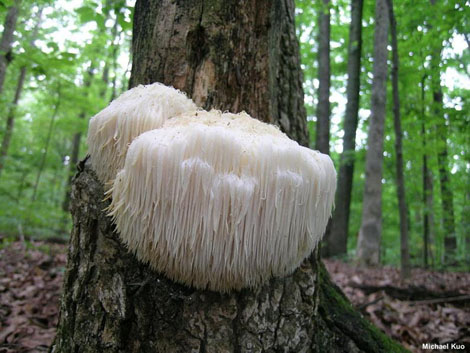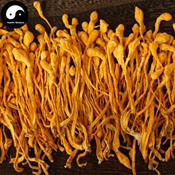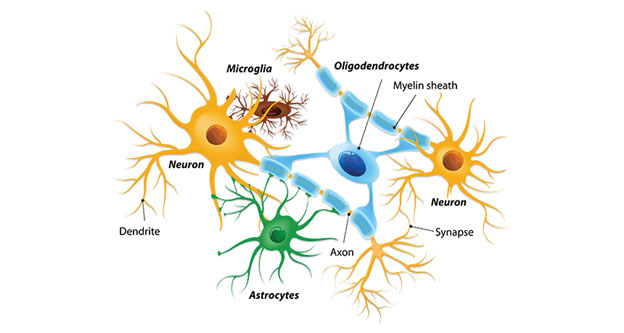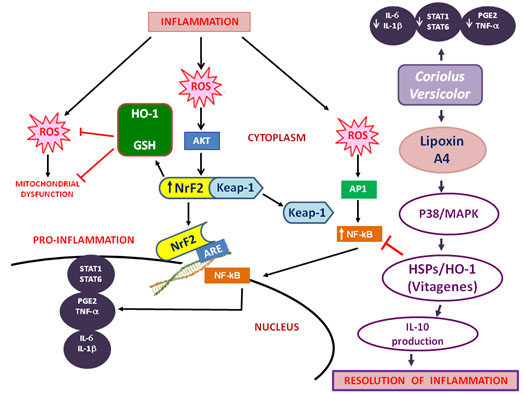Can a mushroom play an important role in the health and anti-aging picture? Recent research says Yes, and this blog entry tells the story
By Vince Giuliano
Current medical treatments for age-related neurological brain diseases like Alzheimer’s and Parkinson’s remain largely ineffective, despite all the medical interventions that have been thrown against them. It may sound crazy, but mushroom-based substances could possibly change that. This blog entry, in two Sections, is about recent research linking up seemingly disparate topics that have been been discussed over the history of this blog. : 1. Neurohormesis, the hormetic stress response, as particularly focused on neuronal/microglial processes, 2. How neurohormesis is likely to be broadly applicable as a strategy for preventing or treating hitherto intractable neuroinflammatory diseases like Alzheimer’s, and 3 how certain mushroom-derived substances, such as from the traditional Lion’s Mane mushroom might be used to elicit hormetic responses for neuroprotection and to prevent or cure neuroinflammatory diseases. 4. Possible implications for cell, organ renewal, and consequent longevity. And finally, 5. Implications for self-biohackers.
In the course of the discussion I will touch on many topics discussed in previous blog entries, including xenohormesis, inflammasomes, microglia-neuron interactions, NRF2, Alzheimer’s and Parkinson’s diseases, the role of stress responses in the evolution of plants, cell-regeneration, lipoxins, nerve growth factor, BDNF, and yet another role for sirtuins.. I am particularly inspired here by the diligent research work on two of my colleagues, Dr. Edward Calabrese of the University of Massachusetts, the long-standing world-leader of hormesis research, and Dr, David Sinclair at the Harvard Medical School who wrote the original publication introducing me to xenohormesis.
I tell the first part of this story in this blog entry. But there is much more of interest for those who want to fight the entropy of Aging. I will round out and complete the story (at least, for now) in the following soon-to-be-published blog entry Inflammation Part 8: Neurohormesis, neuroinflammatory diseases, and their treatment by mushroom substances (Section 2).
This is Part 7 of what is likely to become a 10 or more-part blog series related to chronic inflammation. Being a central aspect of every degenerative disease of old age, chronic inflammation can be thought of as the Great Executioner, the most central machinery of most people’s ultimate illnesses and deaths. Parts 1 through 6 of this series are already published. Part 1 of the series is the same as Part 5 of the NAD world. That blog entry is concerned with The pro-inflammatory effects of eNAMPT (extracellular NAMPT, nicotinamide phosphoribosyltransferase). Part 2 of the series relates a) the “master” pathway network of inflammation (NF-kB) to two other pathway networks clearly implicated in aging and disease processes, b) Genomic Instability (p53), and c) Oxidative stress (Nrf2). Part 3 is concerned with the all-important resolution phase of inflammation, how acute inflammation goes away under ideal conditions instead of hunkering down to lingering and dangerous chronic inflammation. Part 4 of the inflammation series, is concerned with PCSK9 inhibition – Also that blog entry is Part 1 of a series on interventions that reduce all cause mortality (ACM). Part 5 of the series is concerned with the basic science of inflammasomes and how they relate to a number of disease processes. Part 6 of this series is concerned with the scientific considerations behind 4 Herb Synergy, a dietary substance I have invented to control chronic inflammation.
PREAMBLE
In researching the literature related to this topic, like looking for wild mushrooms in the woods, I found potential trails of molecular biology branching off in every-which direction. And my attempts to go off on some of them just led to many more interesting such trail choices, which led to yet-more paths.  So, it has been difficult in this exploration to distinguish between what is of central importance and what is just very interesting. I have sought to confine my coverage here to subtopics that are both, but I am hampered by not knowing what the overall landscape is. I will seek to tell the story as if I were telling a mystery murder novel – element by element, with the hope that by the end the elements will have come together enough for you to get the storyline.
So, it has been difficult in this exploration to distinguish between what is of central importance and what is just very interesting. I have sought to confine my coverage here to subtopics that are both, but I am hampered by not knowing what the overall landscape is. I will seek to tell the story as if I were telling a mystery murder novel – element by element, with the hope that by the end the elements will have come together enough for you to get the storyline.
ELEMENT A: A MAGIC MYSTERY MUSHROOM

Lion’s mane (Hericium erinaceus) Image source
The active ingredients of Lion’s Mane mushrooms (Hericium Erinaceus) appear to be able to activate pathways of regenerative medicine, according to recent research findings. Impacts of consuming the mushroom’s extract include ones related to the brain, CNS and vision, including enhancing neurogenesis(ref), enhancing neuronal plasticity(ref), regenerating neuronal axons(ref), and reducing neuroinflammation(ref). The observed reduction in beta-amyloid plaque accumulations resulting from consuming the mushroom extract(ref), possibly offers an approach to treating Alzheimer’s disease(ref)(ref).
Lion’s Mane mushrooms have been used in China for thousands of years as both a food and as a medicine. This mushroom is commonly found on dead and decaying hardwood logs, most often in the fall throughout North America. By our former summer home in New Hampshire we would often see it on dead and rotting birch tree branches. For an introduction, See Hericium erinaceus: an edible mushroom with medicinal values. (2013). “Mushrooms are considered as nutritionally functional foods and source of physiologically beneficial medicines. Hericium erinaceus, also known as Lion’s Mane Mushroom or Hedgehog Mushroom, is an edible fungus, which has a long history of usage in traditional Chinese medicine. This mushroom is rich in some physiologically important components, especially β-glucan polysaccharides, which are responsible for anti-cancer, immuno-modulating, hypolipidemic, antioxidant and neuro-protective activities of this mushroom. H. erinaceus has also been reported to have anti-microbial, anti-hypertensive, anti-diabetic, wound healing properties among other therapeutic potentials.”
Hericium Erinaceus active ingredients can penetrate the blood-brain barrier and offer excellent bioavailability(ref). Much of the research so far has been on rats, but because of similarity of pathways there is significant probability that findings will carry over to humans. There is lots more to say about Lion’s Mane mushrooms and its components and the possible role they could play in healthy aging. For example, see the 2019 publication Hericium erinaceus Improves Recognition Memory and Induces Hippocampal and Cerebellar Neurogenesis in Frail Mice during Aging.
In fact, in researching this blog, I became so impressed with the substance that 10 days ago I added Lion’s Mane extract to the list of dietary supplements I am taking daily. I am now free of brain fog all day long, and I think it likely helps improve my mental clarity and capability to think-through very complex matters like wrestled with in this blog.
Lion’s Mane extract contains many interesting compounds which could themselves be the subjects of essays. I mention only a couple as examples The 2012 publication Amycenone, a nootropic found in Hericium erinaceum 2012 reports: “The current paper describes the physiological and nootropic actions of Amycenone, which is an activator of brain function that is obtained from extracts of the Yamabushitake (Hericium erinaceum). — Kawagishi and his group have studied compounds that are derived from medicinal mushrooms and their use in the treatment of dementia since 1991. They have found that H. erinaceum exerts important bioactivities, including the induction of nerve growth factor (NGF) synthesis, the inhibition of the cytotoxicity of beta-amyloid peptide, and the protection against neuronal cell death caused by oxidative or endoplasmic reticulum stress. — Since NGF was first discovered in the 1940s, it has garnered attention as a substance in the brain that curbs the degeneration and loss of neurons and that promotes the repair and regeneration of nerve function. However, NGF cannot pass through the blood–brain barrier. — Amysenone (Amyloban®3399, which contains a standardized extract of H. erinaceum) has been found to pass through the blood–brain barrier, and its safety as a health food is currently being ascertained. — On the basis of the author’s first-hand experiences, Amyloban®3399 was found to clearly increase alertness. The actions of Amyloban®3399 in treating sleep-related breathing disorders were examined. Amyloban®3399 was effective in improving sleep apnea and hypopnea syndrome. The use of Amyloban®3399 has been noted to result in the obvious restoration of cognitive function in mild cognitive disorder.”
Another of Lion’s Mane key bioactive ingredients, Erinacine S, has been a particular focus of recent research. Erinacine S is so-far known to be produced only in Hericium Erinaceus mycelia.
And, to top it off Lion’s Mane component substances are also anti-hyperglycemic. The story is told in the 2017 review article Anti-hyperglycemic property of Hericium erinaceus – A mini review. But Lion’s Mane is only Element A of the story I am telling, so I will go on but will return to it repeatably.
Lion’s Mane is not the only interesting medicinal mushroom, though it is the one I focus on here. Back ten years ago, one of my first-published blog entries was about another important medicinal mushroom Cordyceps militaris and cancer, Other mushrooms in addition to Lion’s Mane are known to be capable of exercising therapeutic actions against nervous systems disorders.


Cordyceps Militaris Image source Coriolus versicolor Image source
One of these is is Coriolus versicolor, a mushrooom, well known in China as Yun Zhi. See “Neuroinflammation and Mitochondrial Dysfunction in the Pathogenesis of Alzheimer’s Disease: Modulation by Coriolus Versicolor (Yun-Zhi) Nutritional Mushroom. In fact there are a number more of promising mushroom candidates, See An Overview of Culinary and Medicinal Mushrooms in Neurodegeneration and Neurotrauma Research 2017, and Edible and Medicinal Mushrooms: Emerging Brain Food for the Mitigation of Neurodegenerative Disease, also 2017.
ELEMENT B NEUROTROPHINS
Neurotrophins appear to be central mediators of nervous system cell and organ renewal processes. Researchers need to understand what neurotrophins are about if they want a shot at finding a way for us old folks to renew the brainpower we once had as youths. The first neurotrophin was identified in the mid-1950s, and they have been intensively studied since the early 1990s. Even back then they were known to regulate development, function and maintenance of vertebrate nervous systems. “Neurotrophins activate two different classes of receptors, the Trk family of receptor tyrosine kinases and p75NTR, a member of the TNF receptor superfamily. Through these, neurotrophins activate many signaling pathways, including those mediated by ras and members of the cdc-42/ras/rho G protein families, and the MAP kinase, PI-3 kinase, and Jun kinase cascades. During development, limiting amounts of neurotrophins function as survival factors to ensure a match between the number of surviving neurons and the requirement for appropriate target innervation. They also regulate cell fate decisions, axon growth, dendrite pruning, the patterning of innervation and the expression of proteins crucial for normal neuronal function, such as neurotransmitters and ion channels. These proteins also regulate many aspects of neural function. In the mature nervous system, they control synaptic function and synaptic plasticity, while continuing to modulate neuronal survival.(ref).”
Pubmed.org currently lists 139,458 research articles on neurotrophins. Neurorophins of particular interest to me have included BDNF, NGF and GDNF. A little about each of these:
BDNF (Bain-Derived Neurotrophic Factor).
Way back in 2010 I created a blog entry which is worth reviewing BDNF gene – personality, mental balance, dementia, aging and epigenomic imprinting. “BDNF stands for brain-derived neurotrophic factor, the protein generated by the BDNF gene, a substance that has been drawing a lot of attention recently in neuropsychiatric research circles. I review some basic facts about BDNF here, recent research on how BDNF relates to personality, mental balance, and aging and, finally, current research on how BDNF expression is conditioned by epigenomic imprints. — BDNF acts on certain neurons of the central nervous system and the peripheral nervous system, helping to support the survival of existing neurons, and encourage the growth and differentiation of new neurons and synapses.[4][5] In the brain, it is active in the hippocampus, cortex, and basal forebrain—areas vital to learning, memory, and higher thinking.[6] BDNF itself is important for long-term memory(ref).[7] ” BDNF is an neurotrophic, meaning that it plays an important role in neurogenesis, the important process in parts of the brain of neural stem cells differentiating into neurons. “Neurotrophins are a family of proteins that induce the survival,[1] development and function[2] of neurons. — Brain-derived neurotrophic factor (BDNF) is a neurotrophic factor found originally in the brain, but also found in the periphery. More specifically, it is a protein which has activity on certain neurons of the central nervous system and the peripheral nervous system; it helps to support the survival of existing neurons, and encourage the growth and differentiation of new neurons and synapses through axonal and dendritic sprouting. In the brain, it is active in the hippocampus, cortex, cerebellum, and basal forebrain—areas vital to learning, memory, and higher thinking. BDNF was the second neurotrophic factor to be characterized, after NGF and before neurotrophin-3. — Despite its name, BDNF is actually found in a range of tissue and cell types, not just the brain. Expression can be seen in the retina, the CNS, motor neurons, the kidneys, and the prostate(ref).” — According to the December 30 2009 paper BDNF Val66Met is Associated with Introversion and Interacts with 5-HTTLPR to Influence Neuroticism. “Brain-derived neurotrophic factor (BDNF) regulates synaptic plasticity and neurotransmission, and has been linked to neuroticism, a major risk factor for psychiatric disorders.”
There are many interesting things to say just about BDNF, such as about how it promotes neural plasticity and neurogenesis, and is itself promoted by exercise(ref). Interesting for the present discussion is the link with Element A. Extracts of our mushroom friend Hericium Erinaceus upregulate BDNF signaling. See these articles for examples and discussions. Is unprading BDNF a mechanism through which Lion’s Mane extract does its good stuff? Yes, and I describe additional mechanisms below well. Lion’s Mane extract also activates other neurotrophins – and it can jump across the blood-brain barrier to do so.
NGF (nerve growth factor)
“Nerve growth factor (NGF) is a neurotrophic factor and neuropeptide primarily involved in the regulation of growth, maintenance, proliferation, and survival of certain target neurons. It is perhaps the prototypical growth factor, in that it was one of the first to be described. Since it was first isolated by Nobel Laureates Rita Levi-Montalcini and Stanley Cohen in 1956, numerous biological processes involving NGF have been identified, two of them being the survival of pancreatic beta cells and the regulation of the immune system(Wikipedia).” By now you have probably guessed that our Mushroom friend Lion’s Mane is also a powerful stimulator of NGF, as attested to by these recent professional publications.
 I tell a personal story of how a new recent treatment with NGF appears to have helped my wife in the recent blog entry Funny Things Are Happening To Me On The Way To 100. The treatment, using a recombinant NGF, regenerated neurons in the cornea of one of her eyes and averted constant infections, much pain, and probable blindness in that eye. The neurons in that eye were depleted, meaning stem cells could not freely migrate to the cornea, renewing it. Thinking traditionally, these lost neurons were supposed to have been gone forever. Her vision in that eye is quite good now, and she is awaiting previously impossible cataract surgery on it to bring it up to full potential. This was a powerful up-close example for me of regenerative medicine. Not yet-another “coming to you in the future” story. My life-partner actually restored her seeing, being able to drive, to read comfortably and the quality of her life, I surmise for the rest of her life. Already done-did as far as we can tell. Remember the Zoltar machine and its statement that “Your wish is granted” in the movie Big? That is what NGF said in response to a wish of mine.
I tell a personal story of how a new recent treatment with NGF appears to have helped my wife in the recent blog entry Funny Things Are Happening To Me On The Way To 100. The treatment, using a recombinant NGF, regenerated neurons in the cornea of one of her eyes and averted constant infections, much pain, and probable blindness in that eye. The neurons in that eye were depleted, meaning stem cells could not freely migrate to the cornea, renewing it. Thinking traditionally, these lost neurons were supposed to have been gone forever. Her vision in that eye is quite good now, and she is awaiting previously impossible cataract surgery on it to bring it up to full potential. This was a powerful up-close example for me of regenerative medicine. Not yet-another “coming to you in the future” story. My life-partner actually restored her seeing, being able to drive, to read comfortably and the quality of her life, I surmise for the rest of her life. Already done-did as far as we can tell. Remember the Zoltar machine and its statement that “Your wish is granted” in the movie Big? That is what NGF said in response to a wish of mine.
GDNF (Glial cell line–derived neurotrophic factor)
This neurotrophic factor relates to glial cells and appears to be particularly relevant in the case of Parkinson’s disease. “Glial cell line‐derived neurotrophic factor (GDNF) was first discovered as a potent survival factor for midbrain dopaminergic neurons and was then shown to rescue these neurons in animal models of Parkinson’s disease. GDNF is a more potent survival factor for dopaminergic neurons and the noradrenergic neurons of the locus coeruleus than other neurotrophic factors, and an almost 100 times more efficient survival factor for spinal motor neurons than the (other) neurotrophins(ref).” I have published blog entries in the past on the roles of glia and microglia. See Key roles of glia and microglia in age-related neurodegenerative diseases, and New views of Alzheimer’s disease and new approaches to treating it
And yes, Hericium Erinaceus extracts also promote GDNF. See the publications in this list. Neurotrophins regulate development, maintenance, and function of vertebrate nervous systems.

Image source “This image has drawings of three different types of glial cell — astrocytes, microglia and oligodendrocytes. Each has its own important function. — An adult man has about 85 billion glia and about 86 billion Neurons — cells in the brain that conduct electrical signals.” — Astrocytes provide other brain cells with food and oxygen. Oligodendrocytes wrap around long parts of neurons to help their electrical signals move faster. And microglia help protect the brain from dangerous infections or damage.”
So, the major bottom line of Element B is that neurotrophins are essential for maintenance of healthy essential nerve functioning and that consuming our magic mushrooms activate the expression of multiple neurotrophins facilitating nerve injury repair and avoidance of pathologies associated with nerve loss or dysfunctioning.
ELEMENT C: NEURAL INFLAMMATION AND LIPOXIN AX4
“It has been demonstrated that inflammation cascade is linked to neurodegenerative diseases, particularly, Alzheimer’s disease (AD) [3, 4].” From the publication Neuroinflammation and neurohormesis in the pathogenesis of Alzheimer’s disease and Alzheimer-linked pathologies: modulation by nutritional mushrooms 2018. Neural inflammation is a central aspect of the pathologies associated with all major age-related progressive nervous system diseases, including Alzheimer’s disease, Parkinson’s disease and Lou Gehrig’s disease (Amyotrophic lateral sclerosis (ALS). These are major debilitators and killers of older people. Of course, how neural inflammation plays out in each of these diseases is somewhat different and the scientific literature related to them is far too vast to be characterized here. In short, a summary of salient points:
Neuroinflammation in Alzheimer’s disease
An important theory states “Increasing evidence suggests that Alzheimer’s disease pathogenesis is not restricted to the neuronal compartment, but includes strong interactions with immunological mechanisms in the brain. Misfolded and aggregated proteins bind to pattern recognition receptors on microglia and astroglia, and trigger an innate immune response characterised by release of inflammatory mediators, which contribute to disease progression and severity. Genome-wide analysis suggests that several genes that increase the risk for sporadic Alzheimer’s disease encode factors that regulate glial clearance of misfolded proteins and the inflammatory reaction. External factors, including systemic inflammation and obesity, are likely to interfere with immunological processes of the brain and further promote disease progression. Modulation of risk factors and targeting of these immune mechanisms could lead to future therapeutic or preventive strategies for Alzheimer’s disease.” (From the 2015 review article Neuroinflammation in Alzheimer’s disease.)
Following the suggestion of this hypothysis, we could surmise that approaches that dampen down chronic inflammation might lessen the probability of onset of AD might include:
- To combat systemic inflammation, anti-inflammatory herbal dietary supplements that can penetrate the blood barrier. Blog readers will recognize that I have invented a liposomal preparations of curcumin, ginger, boswellia, ashwagandha explicitly for this purpose(ref)(ref).
- Dietary substances that upregulate the expression of lipoxins that can accelerate the resolution phase of inflammation, so that it goes away by itself. The blog entry Inflammation Part 3: resolving inflammation – resolvins, protectins, maresins and lipoxins discusses substances found in Fish Oils which are lipid mediators of inflammation, leading to resolution of chronic inflammatory situations, that is to natural disappearance of an inflammatory situation such as what we would expect in recovery from a minor infection or insect bite.
Here is a diagram of how Lipoxin A4 is thought to control inflammation. The activating mushroom in this case is shown to be Coriolus Versicolor. It could just as well be Lion’s Mane.

What is new here is that Lion’s Mane (or Coriolus Versicolor) can provide a second mechanism for treating neural disorders. That is,
- Lion’s Mane active ingredients upregulate the expression of lipoxin A4 (LXA4), accelerating the resolution phase of chronic neuroinflammation, and limiting neuropathic inflammation and the pain associated with such inflammation(ref).
- Lion’s Mane extract can cross the blood-brain barrier(ref).
Each of these following links leads to a collection of research literature establishing the point mentioned, among many other points
Herici um Erinaceus lipoxin LXA4– Lion’s Mane extract is efficacious in upregulating this protectin, important for bringing an end to chronic inflammation.
LXA4 neuropathic inflammation – In a variety of disease and pathological situations, the lipoxin LXA4 reduces neuropathic inflammation, reduces microglial activation, and limits neuropathic pain.
From the 2015 publication Lipoxins: nature’s way to resolve inflammation: “An effective host defense mechanism involves inflammation to eliminate pathogens from the site of infection, followed by the resolution of inflammation and the restoration of tissue homeostasis. Lipoxins are endogenous anti-inflammatory, pro-resolving molecules that play a vital role in reducing excessive tissue injury and chronic inflammation. — Lipoxins regulate components of both the innate and adaptive immune systems including neutrophils, macrophages, T-, and B-cells. Lipoxins also modulate levels of various transcription factors such as nuclear factor κB, activator protein-1, nerve growth factor-regulated factor 1A binding protein 1, and peroxisome proliferator activated receptor γ and control the expression of many inflammatory genes.”
ELEMENT D CONTROL OF NEUROPATHIC INFLAMMATION-RELATED PAIN
One of the quality-of-life stakes in the situation we have been discussing is how to bring the persistent and debilitating chronic pain associated with neuroinflammatory conditions under effective control.
LXA4 is triggered by aspirin among other substances, and aspirin-triggered lipoxins play important roles in the resolution of inflammation as laid out in these publications, among others. Also, these aspirin-triggered lipoxins can play important roles in the management of neuropathic inflammation-related pain.
Hericium Erinaceus neuropathic pain – References for Lion’s Mane extract is efficacious in controlling neuropathic pain.
Our old friends (or sometimes enemies), inflammasomes and neuropathic pain
The 2013 publication Involvement of the spinal NALP1 inflammasome in neuropathic pain and aspirin-triggered-15-epi-lipoxin A4 induced analgesia suggests a mechanism through which neuroinflammation leads to neuropathic pain. “Neuroinflammation plays an important role in nerve-injury-induced neuropathic pain, but the explicit molecular mechanisms of neuroinflammation in neuropathic pain remain unclear. As one of the most critical inflammatory cytokines, interleukin-1β (IL-1β) has been regarded as broadly involved in the pathology of neuropathic pain. The inflammasome caspase-1 platform is one primary mechanism responsible for the maturation of IL-1β. Lipoxins, a type of endogenous anti-inflammatory lipid, have proved to be effective in relieving neuropathic pain behaviors. The present study was designed to examine whether the inflammasome caspase-1 IL-1β platform is involved in chronic constriction injury (CCI)-induced neuropathic pain and in lipoxin-induced analgesia. After rats were subjected to the CCI surgery, mature IL-1β was significantly increased in the ipsilateral spinal cord, and the inflammasome platform consisting of NALP1 (NAcht leucine-rich-repeat protein 1), caspase-1 and ASC (apoptosis-associated speck-like protein containing a caspase-activating recruitment domain) was also activated in spinal astrocytes and neurons, especially at the superficial laminae of the spinal dorsal horn; The aspirin-triggered-15-epi-lipoxin A4 (ATL), which shares the potent actions of the endogenous lipoxins, was administered to the CCI rats. Repeated intrathecal injection with ATL markedly attenuated the CCI-induced thermal hyperalgesia and significantly inhibited NALP1 inflammasome activation, caspase-1 cleavage, and IL-1β maturation. These results suggested that spinal NALP1 inflammasome was involved in the CCI-induced neuropathic pain and that the analgesic effect of ATL was associated with suppressing NALP1 inflammasome activation.”
This discussion related to neuroinflammation was started with particular reference to Alzheimer’s disease. Very similar discussions could be framed starting with any of the other neuroinflammatory diseases. I strongly suspect that the preventative and therapeutic implications for use of extracts of Lion’s Mane and possibly other mushrooms are applicable across the board for most of these maladies.
ELEMENT F NEUROHORMESIS
Members of every known biological species experiences stress threats to their wellbeing, and there are some stresses that threaten their members very existence. And all species have developed their own biological responses to commonly occurring stresses. The more complex and sophisticated the organism, the more numerous and more complex these stress responses tend to be, and the more levels they operate on, e.g. cellular, cell organelle, system of molecular biology, organ, major body system, etc. A quite universal property of these stress responses is that they exhibit hormesis; they are hormetic. That is, for mild levels of the stress up to a certain point, the natural stress response is sufficient to make the organism better off, more robust and healthy, than if there were no stress in the first place. So, low doses of many stresses can be used to induce health and in some cases, possibly longevity. There are countless examples of hormesis such as surgical pre-conditioning to improve outcomes by restricting blood flow, heat stress in saunas and cold streses via ice baths, to psychological stress in basic military training. Calorie restriction, the best documented intervention for extending the lifespan of animals, is a hormetic interventions. If the stress is above a certain level, of course, the organism may become damaged or die. Hormesis is fundamental to biology and the need for it can be understood by thinking of biological process in terms of systems control theory. Jim Watson and I have published a number of articles related to hormesis and hormesis-related health interventions in this blog, most of which can be found in this listing.
Neurohormesis involves generating sub-toxic stresses on nervous tissues, and can be used as a disease-preventative and health and longevity-inducing intervention. Exercise itself is an example applicable to nervous and muscle tissues, as are cognitive and physical challenges. Neurohormesis induced by certain herbal substances like curcumin or boswellia, another kind of example, can work through generating stresses that downregulate the NF-kB pathway and upregulate NRF2 pathway, not only inhibiting the expression of inflammatory cytokines in nervous tissues, but also upgrading the expression of hundreds of stress responsive ARE (antioxidant response element) proteins and limiting microglial and inflammasome activation(ref)(ref). And the actions discussed and illustrated above of Lion’s Mane and other mushroom substances in controlling neuroinflammation via upgrading the LXA4 lipoxin are also hormetic effects. Again, these are topics that have been discussed extensively in this blog(ref)(ref).
RECAP OF THE STORY SO FAR
- Recent research confirms that extracts of a traditional medical mushroom, Lion’s Mane (Hericium erinaceus) appear to have amazing clinical powers to affect nervous tissues, including enhancing neurogenesis, enhancing neuronal plasticity, regenerating neuronal axons, reducing neuroinflammation, and reducing beta-amyloid plaque accumulations. Further, it appears that key compounds in the extract have the capability of crossing the blood-brain, so they can get to where they could be needed in the brain and CNS. Research publications suggest that the same may be said of certain other mushrooms, e.g. coriolus versicolor.
- Recent research has also pointed to key mechanisms for the neural implications of Lion’s Mane being the upregulation of endogenous molecules known as Neurotrophins, including nerve growth factor (NGF), brain-derived neurotrophic factor (BDNF) and glial cell line–derived neurotrophic factor (GDNF). Neurotrophins are essential for maintenance of healthy essential nerve functioning. Consuming Lion’s Mane extract upregulates the expression of multiple neurotrophins facilitating nerve injury repair and avoidance of pathologies associated with nerve loss or dysfunction.
- A key aspect of neurodegenerative diseases like Alzheimer’s, and Parkinson’s is chronic neuroinflammation, which gets “locked in” via inflammasome activation as part of the disease process and then plays important roles in furthering progression of the disease. So, a second mechanism of Lion’s Mane extract for dealing with neuroinflammatory diseases is the upregulation of an inflammation-resolving lipoxin LXA4.
WHERE I WILL BE GOING IN THE NEXT Section 2 BLOG ENTRY
Yes, I have been pointing out why extracts of a couple of ancient and traditional mushrooms may possibly be useful right now by health biohackers to help control neuropathic inflammation and awful neuropthic back and other pains, and may lead us to simple, practical and effective means for averting and controlling neurodegenerative diseases I will cover this topic listing additional elements in the following Section 2 blog entry which I will likely publish in about another week. In that blog entry I will discuss neural regeneration and the roles of lipoxins in initiating that, address the critical roles of glia and microglia in nervous system health, say more on control of neuropahic lower back pain, relate implications for wound healing, more on Alzheimer’s and Parkinson’s diseases and the prospectus for averting or controlling them with mushroom substances. And I will hazard projecting how long it will take for this information to seep into medical practice. And I will speculate on what self-health hackers can do to keep themselves going happily in the interim.
REMINDER: PHONE CALL-IN SESSIONS – TALK LONGEVITY WITH VINCE
I am experimenting with weekly call-in group conversations, Tuesday evenings 7:00 – 8:00 pm EDT. Second regular Tuesday session will be, October 15. The agenda of the conversations will be up to you. Any topic of health or longevity is fair game. And all who will have joined the phone conversation will be free to join in. Be aware though that I plan to record the conversations and might want to use parts of them on this or other blogs. I plan to keep the conference line open for conversations during the 7-8 pm time frames no matter how many call in, even if it is just to chat with a single caller. I have so far scheduled these through Nov 11th but will keep them going after that if there is sufficient interest.
Vince Giuliano is inviting you to a scheduled Zoom meeting.
Join Zoom Meeting
https://us04web.zoom...lRXd0I2MVBmQT09
Tuesday Meeting ID: 500 754 984 Tues mtgs Password: 004871
One tap mobile
+16468769923,,500754984# US (New York)
+14086380968,,500754984# US (San Jose)
Dial by your location
+1 646 876 9923 US (New York)
+1 408 638 0968 US (San Jose)
+1 669 900 6833 US (San Jose)
Tuesdays Meeting ID: 500 754 984 Mon Oct s Meeting ID: 409-297-457
Find your local number: https://us04web.zoom.us/u/fisIuyStX
(If you have a problem calling from the country you are in, please let me know and I will see if I can add that country to the list for incoming calls — Vince)
MEDICAL DISCLAIMER
FROM TIME TO TIME, THIS BLOG DISCUSSES DISEASE PROCESSES. THE INTENTION OF THOSE DISCUSSIONS IS TO CONVEY CURRENT RESEARCH FINDINGS AND OPINIONS, NOT TO GIVE MEDICAL ADVICE. THE INFORMATION IN POSTS IN THIS BLOG IS NOT A SUBSTITUTE FOR A LICENSED PHYSICIAN’S MEDICAL ADVICE. IF ANY ADVICE, OPINIONS, OR INSTRUCTIONS HEREIN CONFLICT WITH THAT OF A TREATING LICENSED PHYSICIAN, DEFER TO THE OPINION OF THE PHYSICIAN. THIS INFORMATION IS INTENDED FOR PEOPLE IN GOOD HEALTH. IT IS THE READER’S RESPONSIBILITY TO KNOW HIS OR HER MEDICAL HISTORY AND ENSURE THAT ACTIONS OR SUPPLEMENTS HE OR SHE TAKES DO NOT CREATE AN ADVERSE REACTION.
View the full article at Anti-Aging Firewalls









































